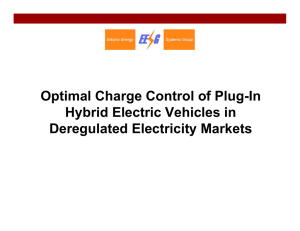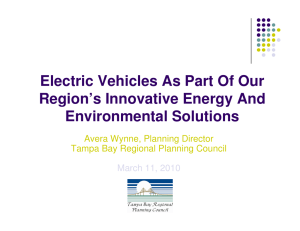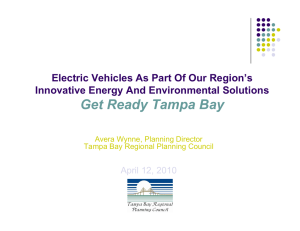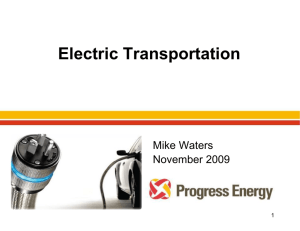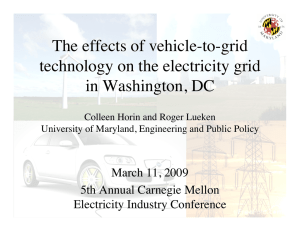Effects of Plug-In Hybrid Electric Vehicles on the Vermont Electric
advertisement
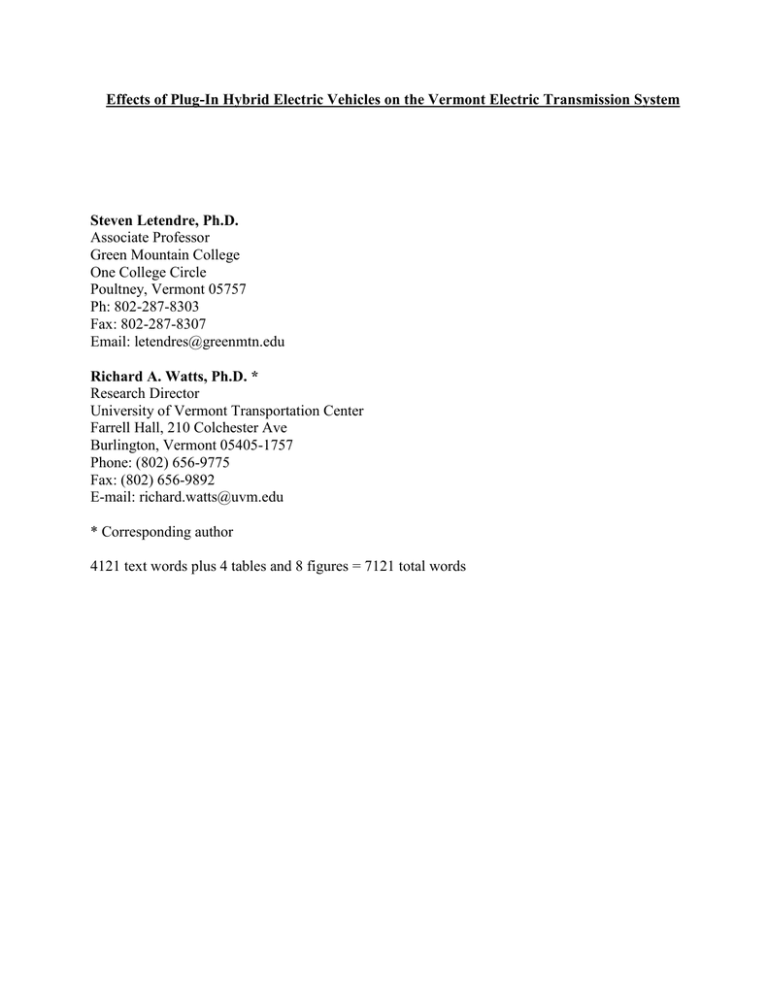
Effects of Plug-In Hybrid Electric Vehicles on the Vermont Electric Transmission System Steven Letendre, Ph.D. Associate Professor Green Mountain College One College Circle Poultney, Vermont 05757 Ph: 802-287-8303 Fax: 802-287-8307 Email: letendres@greenmtn.edu Richard A. Watts, Ph.D. * Research Director University of Vermont Transportation Center Farrell Hall, 210 Colchester Ave Burlington, Vermont 05405-1757 Phone: (802) 656-9775 Fax: (802) 656-9892 E-mail: richard.watts@uvm.edu * Corresponding author 4121 text words plus 4 tables and 8 figures = 7121 total words ABSTRACT Plug-in hybrid electric vehicles (PHEVs) have emerged as a near-term technology to reduce the nation’s dependence on imported petroleum, address rising gasoline prices, and reduce carbon emissions from the transportation sector. This paper presents the results of a PHEV grid impact study for the State of Vermont—a small power system with peak demand of approximately 1 GW. The study looked at three different PHEV penetration rates and three different charging scenarios. Uncontrolled charging regimes even at a low PHEV penetration rate of 50,000 vehicles (~ 9% of the Vermont light duty vehicle fleet) could lead to an increase in the peak demand for electric power in Vermont. However, a delayed nighttime charging regime could accommodate 100,000 PHEVs without adding to system peaks. Furthermore, next generation smart grid technology using optimal charging algorithms could accommodate 200,000 PHEVs, or approximately one-third of Vermont LDVs. As previous studies have found, displacing conventional ICE vehicles with PHEVs can reduce GHG emissions and decrease consumer fuel costs. INTRODUCTION Increasing the number of plug-in hybrid electric vehicles (PHEVs) on the nation’s roads has been identified as a critical strategy for reducing U.S. dependence on imported petroleum (1). Individual states have identified PHEVs as an important element in their transportation GHG reduction strategies (2). Vermont policy-makers have identified PHEVs as a critical greenhouse gas (GHG) reduction strategy for the transportation sector for several reasons. Vermonters are extremely dependent on personal automobiles for most trips with a per capita vehicle miles traveled (VMT) of 12,379 – the fifth highest in the U.S. (3). Yet the state has the lowest carbon electric generation mix in the nation because of the reliance on hydro-power and nuclear power (0.014 kg/kWh compared to a U.S. average of 0.61 kg/kWh) (4). Vermont state government, private utilities and other entities have funded a series of demonstrations and experiments with electric and PHEV vehicles starting in 1991. As the possibility of the wide-scale availability of PHEVs increases, electric utilities and Vermont policy-makers are interested in understanding the effect of large numbers of PHEVs on the electric grid, GHG emissions and end-user costs (5). This paper focuses on the effect on the electric grid of the deployment of 50,000, 100,000 or 200,000 PHEVs. A number of studies have modeled the impact of differing numbers of PHEVs on large state and regional electric grids, GHG emissions and end-user costs (6, 7, 8, 9, 10, 11, 12, 13, 14, 15, 16). We reviewed those studies for methodologies to examine the effect of the large-scale deployment of PHEVs in Vermont. The PHEV technical specifications that emerged from the Hybrid Electric Vehicle Working Group (WG) convened by the Electric Power Research Institute (EPRI) have served as essential groundwork on the effects of PHEV deployments. In the absence of manufactured PHEVs, the EPRI studies provide specifications for a mid-sized sedan PHEV (2001) and technical specifications for a compact sedan, and mid-sized and full-sized SUVs (2002) (6, 7). Table 1 lists the PHEV technical specifications described in the reports. TABLE 1 Technical Specifications for PHEV20 in Compact Sedan, Mid-Size Sedan, Mid-Size SUV, and Full-Size SUV Vehicle Platforms. Units Motor Rated Power Nominal Battery Pack Size Battery Rated Capacity Miles per Gallon Fuel Economy Electric Only Economy All Electric Efficiency Mileage Weighted Probability Fuel Economy Vehicle Mass Charging time kW kWh usable kWh+ mpg (PHEV/ICE§) mpeg* (miles/kWh) (MWP)@ PHEV20 compact sedan 37 5.1 4.1 52.7/37.7 134 4.0 71.7 PHEV20 midsize sedan 51 5.9 4.7 43.5/28.9 117 3.49 58 PHEV20 midsize SUV 84 7.9 6.3 34.7/22.2 90.5 2.7 46.6 PHEV20 fullsize SUV 98 9.3 7.4 29.5/18.2 77 2.3 39.8 kg 1,292 1,664 2,402 2,824 (hours, 120 V 15 4 4.7 6.3 7.4 amp, 1 kW)^ Charging time (hours, 120 V 20 3 3.5 4.7 5.6 amp, 1.3kW)^ Charging time (hours, 240 V 40 0.7 0.8 1.1 1.3 amp, 5.7 kW)^ + The battery rated size is assumed to be 80% of the nominal pack size. § This row gives the miles per gallon (mpg) for PHEVs as compared to internal combustion engines (ICE) – a standard gasoline vehicle. *The report expresses the all electric range as miles per energy equivalent gasoline gallon (mpeg). This calculation assumes 33.44 kWh per gallon of gasoline. @ The mileage weighted probability (MWP) fuel economy provides an estimate of a blended electric/gasoline operation efficiency. The MWP gives an estimation of what portion of PHEV’s daily annual mileage will be in all electric mode based on national driving statistics. The values presented in the table assume nightly charging of the vehicle. ^The charging rate per hour assumes an 80% required safety factor for continuous charging and assumes an 82% efficiency for 120 V chargers and 87% for 240 V chargers and 85% battery efficiency. The first measure of fuel economy in Table 1 is the gasoline miles per gallon, which indicates the lower bound mileage number based on the vehicle operating in charge sustaining mode similar to conventional hybrid electric vehicles sold today. The second fuel economy measure is based on operation of the vehicle in electric-only mode and is expressed as the miles per energy equivalent of a gallon of gasoline (mpeg). The energy content of a gallon of gasoline is expressed in terms of electrical energy at 33.44 kWh per gallon to derive this value. The MPEG serves as the upper bound efficiency potential of the vehicle. The ―Mileage Weighted Probability Fuel Economy‖ presented in Table 1 is an attempt to present a likely ―real world‖ fuel economy estimate based on a statistical approximation of the number of miles driven each year in all-electric mode and with the vehicle being recharged nightly. The technical parameters of PHEVs developed by the EPRI WG may not necessarily conform to those of PHEVs that ultimately reach the market but serve as an approximation in terms of what to expect regarding PHEV characteristics and performance. Building on the EPRI WG reports, five recent studies have analyzed the electric grid impacts from an emerging fleet of PHEVs. While there are some similarities across the studies, each one takes a different approach in terms of the electric system, PHEV configurations, and charging scenarios analyzed. The studies find generally that the existing electric power infrastructure is capable of charging large fleets of PHEVs without the need to build additional generation, transmission, or distribution infrastructure. Table 2 lists the grid impact studies reviewed here, along with some key features of each (8, 9, 10, 11, 12). TABLE 2 PHEV Grid Impact Studies. Title & Date Impacts Assessment of Plug-In Hybrid Vehicles on Electric Utilities and Regional U.S. Power Grids (2007) An Evaluation of Utility System Impacts and Benefits of Optimally Dispatched PlugIn Hybrid Electric Vehicles (2006) Authors’ Name and Affiliation Kintner-Meyer, Schneider and Pratt, Pacific Northwest National Laboratory Denholm and Short, National Renewable Energy Laboratory Geographic Focus Entire U.S., based on 12 modified North American Electric Reliability Council regions Six different geographic regions, using hourly load data from electric utility control areas. Vehicle Configuration PHEV33, this vehicle configuration is used to estimate the electricity consumption that would satisfy the average daily commute as determined by travel survey data. This study simulated the energy requirements of a PHEV fleet that meets on average 40% of its daily miles traveled with electricity. This translates into a PHEV with an allelectric range between 20 and 40 Charging Emissions Scenario(s) Assessment The study assumes Yes all excess capacity is used. Produces estimates based on 24-hour charging and 12-hour charging scenarios. Charging is based No on an optimized 24hour cycle assuming direct utility control of when the vehicles are charged. Costs and Emissions Associated with Plug-In Hybrid Electric Vehicle Charging in the Xcel Energy Colorado Service Territory (2007) Effects of Plug-In Hybrid Electric Vehicles in California Energy Markets (2007) Parks, Denholm and Markel, National Renewable Energy Laboratory This study was focused specifically on Xcel Energy’s Colorado service territory. Lemoine, Kammen and Farrell, Energy and Resources Group at the University of California Berkeley This study used load data from the California Independent System Operator and thus was focused exclusively on CA. miles. A mid-size PHEV20 vehicle with 37 mpg gasoline and 2.78 miles/kWh and 7.2 kWh of battery storage capacity. Four charging Yes scenarios were evaluated: uncontrolled charging; delayed charging; off-peak charging; and continuous charging. Three charging No scenarios were modeled: optimal charging, evening charging, and twice a day charging. A compact PHEV20 vehicle with 50 mpg gasoline, 130 mpeg, and 5 kWh of usable stored energy. Also conducted sensitivity analysis using a fullsize SUV. Potential Impacts Hadley and This study focuses A mixture of sedans 182 scenarios: 7 Yes of Plug-in Hybrid Tsvetkova, U.S. on the entire U.S. but and sport utility scenarios for each Vehicles on Department of divides its scenarios vehicles. region for 2020 and Regional Power Energy Oak Ridge into the 13 Energy 2030, with a base Generation National Information Agency scenario, different (2008) Laboratory regions. electricity mixes, and 2 charging scenarios (5:00 pm and 10:00 pm) Some of the studies detailed above and several others have looked at the emissions reductions from replacing ICEs with PHEVs (13, 14, 16). The EPRI WG studies, for example, calculated the net greenhouse gas emissions and smog precursor emissions on a per vehicle basis to allow for comparisons (6, 7). Three of the grid impact studies also assessed the net emission impacts from an emerging fleet of PHEVs (8, 10, 11). In addition, one recent study which focused exclusively on the emissions implications from the introduction of PHEV technology was conducted jointly by the Natural Resources Defense Council (NRDC) and EPRI (13, 14). Most of the studies of net emissions suggest a clear benefit in terms of reduced CO2 emissions as the percent of PHEVs in the nation’s fleet increase. This result is driven largely by the efficiency improvements along the electricity generation path as compared to the fuel-cycle chain for gasoline (16). However, a recent study by Hadley and Tsvetkova (found that PHEVs would increase carbon dioxide emissions compared to hybrid electric vehicles (HEV) under most scenarios (12). PHEV ELECTRIC GRID IMPACTS IN VERMONT Analysis of the impact of PHEVs on the electric grid requires the development of several scenarios and assumptions. Firstly, load impact studies develop load profiles for typical summer and winter days (8). Secondly, these studies develop different scenarios for the number of PHEVs in the study area fleets. For example, in Lemoine et al (2007), the system load impacts were calculated for 1, 5, and 10 million PHEVs charging from the California grid, assuming an effective charging rate of 1 kW (11). Thirdly, a key assumption in the analysis is the battery size and electric range of the PHEV to be modeled. Parks, Denholm, and Markel (2007) used a PHEV20 vehicle configuration to model the utility system impacts of 500,000 vehicles, roughly 30 percent of the 1.7 million vehicles in the Xcel service territory (10). A fourth key decision in the analysis is the type of charging regimes to model. In the Pacific Northwest study the researchers modeled four charging scenarios; uncontrolled charging, delayed charging, off-peak charging and continuous charging to understand the power system impacts of a range of possible consumer charging preferences (8). In this study, we started by identifying peak summer and winter season days. Hourly electric load data representing the Vermont demand at the transmission level was adjusted to account for line losses through the distribution network. In addition, average load profiles for each of the four seasons were constructed to assess PHEV load impacts for an ―average‖ load day in each season. The seasons were defined as follows: Winter—December, January, and February. Spring—March, April, and May Summer—June, July, and August Fall—September, October, and November Three different PHEV penetration scenarios were assessed. The low penetration scenario evaluated the grid impacts of a fleet of 50,000 PHEVs – about 9 percent of the total light duty vehicle (LDV) fleet. The second scenario assumed a fleet of 100,000 PHEVs or approximately 17 percent of LDVs registered in Vermont. The high penetration scenario at 200,000 vehicles – more than 35 percent of the total LDV fleet, also illustrated the possible effects from a smaller number of all-electric vehicles or PHEVs with higher all-electric ranges than a PHEV20, both of which would create higher per vehicle consumption of electricity. The researchers developed a PHEV vehicle profile with an electric range of 20 miles and a charge time of six hours. TABLE 3 PHEV 20 Technical Specifications for Vermont Study Nominal Battery Pack Size (kWh) Usable Energy in Battery Pack (kWh) Round Trip Battery Efficiency (%) Charger Efficiency (%) Charge Rate (kW) Time for Full Charge (hours) Purchased Electricity per Charge (kWh) Electric Efficiency (miles / kWh) All Electric Range (miles) 7.5 6 85 82 1.4 6 8.4 3.49 20 The researchers developed four different charging scenarios. 1) Uncontrolled Evening Charging: In this scenario it is assumed that the vehicle owner begins charging the vehicle upon arriving home from work. Charging start times are evenly distributed between 6:00 pm, 7:00 pm, and 8:00 pm. Each PHEV charges for 6 continuous hours. 2) Uncontrolled Evening Charging / Twice Per Day Charging: This scenario represents the worse case, whereby uncontrolled charging in the evening is paired with daytime charging. Each PHEV is assumed to be plugged in to charge fully at the end of each commute leg. Each vehicle fully charges twice each day, once upon arriving at work in the morning and once upon arriving home in the evening. The daytime charging start times are evenly distributed between 8:00 am and 9:00 am. The evening charging times are evenly distributed between 6:00 pm, 7:00 pm, and 8:00 pm. 3) Delayed Nighttime Charging: This scenario assumes that either off-peak rates for PHEV charging or direct load control are used to delay PHEV charging times until 12:00 am. It is assumed that the entire PHEV fleet begins charging at midnight and ends at 6:00 am. 4) Optimal Nighttime Charging. This represents the best case scenario from the grid operator’s perspective. The vehicles are charged in a pattern that increases utility load factors by charging during the periods of lowest demand. Utilities are assumed to have next generation smart grid technology using optimal charging algorithms to control charging regimes. This scenario illustrates the possible beneficial load-leveling effects of PHEVs. Table 4 lists the MW demand and total energy for each scenario. Table 4 also provides comparisons of PHEV energy requirements and contribution to peak demand based on total electric energy consumed in Vermont in 2005. TABLE 4 Demand and Energy Assessment for Three PHEV Penetration Scenarios 50,000 PHEVs 74 MW 7.15 % 7.01% 445 MWh Demand % Summer Peak (1,038 MW) % Winter Peak (1,054 MW) Daily Energy (1 charge per day) Annual Energy (1 charge 365 days) % 2005 MWh (6,325,960) Daily Energy (2 charges per day) Annual Energy (2 charges per day) % 2005 MWh (6,325,960) 100,000 PHEVs 148 MW 14.30 % 14.03 % 890 MWh 200,000 PHEVs 297 MW 28.59 % 28.05 % 1,781 MWh 162,498 MWh 324,996 MWh 649,992 MWh 2.57 % 890 MWh 5.14 % 1,781 MWh 10.27 % 3,562 MWh 324,996 MWh 649,992 MWh 1,299,984 MWh 5.14 % 10.27 % 20.55 % MW Load Uncontrolled Evening Charging Figures 1 and 2 depict the load impacts from uncontrolled evening charging on the summer and winter peak day load profiles for each of the three PHEV penetration scenarios. 1300 Summer Peak 1200 50 k PHEVs 1100 100 k PHEVs 1000 200 k PHEVs 900 800 700 600 500 1 3 5 7 9 11 13 15 17 19 21 23 Time of Day FIGURE 1 Summer Peak PHEV Load Impacts: Uncontrolled Evening Charging MW Load 1300 Winter Peak 1200 50 k PHEVs 1100 100 k PHEVs 1000 200 k PHEVs 900 800 700 600 500 1 3 5 7 9 11 13 15 17 19 21 23 Time of Day FIGURE 2 Winter Peak PHEV Load Impacts: Uncontrolled Evening Charging The uncontrolled charging scenario in most cases would add to the system peak. The low penetration scenario’s impact on the summer peak load is minimal; it simply extends the peak period into the evening hour, but on an absolute basis does not increase the peak demand for the day. However, both the medium and high PHEV penetration scenarios would increase peak demand on the peak summer day. In the uncontrolled charging scenario, one-third of the PHEV fleet begins charging at 6:00 pm, exactly the time when the peak demand occurred on the peak winter day in 2005. As a result, all of the PHEV penetration scenarios analyzed would add to the system peak. In the winter months, the early evening peak is driven by residential energy use. Given that PHEVs represent a significant household load, charging when returning home from work would increase early evening peak demand for electrical energy during the cold weather months. MW Load Uncontrolled Evening Charging / Twice Per Day This charging scenario represents the worst case scenario with vehicle drivers charging at both ends of their work-day commute. Figures 3 and 4 depict the load impacts for each of the three PHEV penetration scenarios. 1400 Summer Peak 1300 50 k PHEVs 1200 100 k PHEVs 1100 200 k PHEVs 1000 900 800 700 600 500 1 3 5 7 9 11 13 15 17 19 21 23 Time of Day FIGURE 3 Summer Peak PHEV Load Impacts: Twice per Day Charging MW Load 1300 Winter Peak 1200 50 k PHEVs 1100 100 k PHEVs 1000 200 k PHEVs 900 800 700 600 500 1 3 5 7 9 11 13 15 17 19 21 23 Time of Day FIGURE 4 Winter Peak PHEV Load Impacts: Twice per Day Charging The addition of a second charge increased demand during the daytime hours, in this case from 8:00 am through 2:00 pm. Based on the load curve for the peak summer day, the daytime charging would increase the daily peak demand for electricity with demand rising slowly through the afternoon and reaching a peak around 2:00 pm. Based on the load impact analysis for the peak winter day, the second charge event appears to be less problematic for the low and medium PHEV penetration scenarios. Given the sharp increase in demand in the early evening hours, the second charge event associated with the high PHEV penetration scenario is the only scenario that would lead to a new daytime peak. Delayed Nighttime Charging This charging scenario assumed that either through financial incentives such as off-peak rates or direct utility control, the PHEVs do not begin charging until 12:00 am midnight. Figures 5 and 6 depict the load impacts from the three PHEV penetrations scenarios for the summer and winter peak days. 1100 MW Load 1000 900 Summer Peak 800 50 k PHEVs 700 100 k PHEVs 600 200 k PHEVs 500 1 3 5 7 9 11 13 15 17 19 21 23 Time of Day FIGURE 5 Summer Peak PHEV Load Impacts: Delayed Nighttime Charging 1100 MW Load 1000 900 800 Winter Peak 700 50 k PHEVs 100 k PHEVs 600 200 k PHEVs 500 1 3 5 7 9 11 13 15 17 19 21 23 Time of Day FIGURE 6 Winter Peak PHEV Load Impacts: Delayed Nighttime Charging Figures 5 and 6 illustrate that a large number of PHEVs could charge from the Vermont grid without adding to system peak demand under a delayed nighttime charging scenario. Penetration rates of more than 100,000 vehicles, or approximately 17 percent of the Vermont LDV fleet, could be accommodated without the need to build additional generation and transmission. The high penetration scenario studied here—200,000 PHEVs or one-third of the LDV fleet—would require additional power system infrastructure in this scenario. Optimal Nighttime Charging This scenario assumes total utility control of PHEV charging regimes. Figures 7 and 8 illustrate the load impacts from various PHEV penetration scenarios on the summer and winter peak load. 1100 MW Load 1000 900 Summer Peak 800 50 k PHEVs 700 100 k PHEV 600 200 k PHEVs 500 1 3 5 7 9 11 13 15 17 19 21 23 Time of Day FIGURE 7 Summer Peak PHEV Load Impacts: Optimal Nighttime Charging 1100 MW Load 1000 900 Winter Peak 800 50 k PHEVs 700 100 k PHEV 600 200 k PHEVs 500 1 3 5 7 9 11 13 15 17 19 21 23 Time of Day FIGURE 8 Winter Peak PHEV Load Impacts: Optimal Nighttime Charging Figures 7 and 8 illustrate that an optimal charging strategy would allow 200,000 PHEVs to fully charge daily from the Vermont grid without adding to system level peak demand. However, this assumes utilities have the technology to control PHEV charging regimes. CONCLUSION A large fleet of PHEVs could be accommodated in Vermont without the need to build additional generation, transmission, or distribution infrastructure. However, this would require either financial incentives for off-peak charging or direct utility control of PHEV charging. Simple delayed charging beginning at 12:00 am and ending with a full charge for the morning commute could accommodate over 100,000 PHEVs, or 17 percent of the Vermont light vehicle fleet, without adding to the system peak. PHEV fleets over 100,000 would require some form of direct utility control to smooth the additional PHEV load during the off-peak hours to avoid adding to the peak power demand in Vermont. Preferential rates offered by electric utilities to incentivize off-peak charging would also further reduce the MPEG costs to PHEV vehicle users (17). For example, the PHEV20 detailed in the analysis above delivers 2.38 miles of travel for every kWh purchased from the grid. Vermont’s largest electric utility presently offers an off-peak rate of $0.7/kWh. If the PHEV is replacing a vehicle that averages 30 miles per gallon, a PHEV owner would require 12.6 kWh to travel the same distance as one gallon of gasoline. At an electricity cost of $0.7/kWh, the electricity equivalent cost of a gallon of gasoline would be just $.88. Critical to this analysis is the reference vehicle the PHEV is replacing and the actual cost of the electricity. Further research is needed to more fully understand PHEV drivers travel behavior and performance of PHEVs in Vermont and compare them to suitable reference vehicles. This study has examined these issues at a macro level relying on methodologies and assumptions made in prior studies. Another area of considerable interest is vehicle-to-grid capability where utilities use the energy stored in parked PHEVs as load leveling devices (18). Additional research is needed to investigate the potential benefits of this technology given reasonable assumptions about the deployment rate of new PHEVs in the state. ACKNOWLEDGEMENTS The authors thank the University of Vermont Transportation Research Center for funding this research and our research partners and collaborators at Central Vermont Public Service, Green Mountain Power, the Vermont Department of Public Service and Burlington Electric Department. REFERENCES 1. National Economic Council. Advanced Energy Initiative. February, 2006. www.whitehouse.gov/stateoftheunion/2006/energy/. Accessed July 28 2008. 2. Gallivan, F., J. Ang-Olson, and W. Schroeer. Innovations in State-Led Action to Reduce Greenhouse Gas Emissions from Transportation: The State Climate Action Plan. Presented at the 87th Annual Meeting of the Transportation Research Board, Washington, D.C., 2008. 3. U.S. Department of Transportation. Bureau of Transportation Statistics. Table 5-3: Highway Vehicle-Miles Traveled (VMT). www.bts.gov/publications/state_transportation_statistics/ state_transportation_statistics_2006/html/table_05_03/ Accessed July 31, 2008. 4. Energy Information Administration, Office of Integrated Analysis and Forecasting. Energy Information Administration U.S. Department of Energy. Updated State-level Greenhouse Gas Emission Coefficients for Electricity Generation 1998-2000. EIA, Washington, D.C. April 2002. 5. Vermont Department of Public Service. 2005 Electric Plan. DPS, Montpelier, 2006. Accessed July 30, 2008. 6. Electric Power Research Institute. Comparing the Benefits and Impacts of Hybrid Electric Vehicle Options. Publication EPRI 1000349. Electric Power Research Institute, 2001. 7. Electric Power Research Institute. Comparing the Benefits and Impacts of Hybrid Electric Vehicle Options for Compact Sedan and Sport Utility Vehicles. Publication EPRI 86. Electric Power Research Institute, 2002. 8. Kintner-Meyer, M., K. Schneider, and R. Pratt. Impact Assessment of Plug-In Hybrid Vehicles on Electric Utilities and Regional U.S. Power Grids Part 1: Technical Analysis. Pacific Northwest National Laboratory, 2007. 9. Denholm, P. & W. Short. An Evaluation of Utility System Impacts and Benefits of Optimally Dispatched Plug-in Hybrid Electric Vehicles. Publication NREL/TP-620-40293. National Renewable Energy Laboratory, 2006. 10. Parks, K., P. Denholm, and T. Markel. Costs and Emissions Associated with Plug-In Hybrid Electric Vehicle Charging in the Xcel Energy Colorado Service Territory. Publication NREL/TP-640-41410. National Renewable Energy Laboratory, 2007. 11. Lemoine, D., D. Kammen, & A. Farrell. Effects of Plug-In Hybrid Electric Vehicles in California Energy Markets. Presented at the 86th Annual Meeting of the Transportation Research Board, Washington, D.C., 2007. 12. Hadley, W. S., and A. Tsvetkova. Potential Impacts of Plug-In Hybrid Electric Vehicles on Regional Power Generation. Publication ORNL/TM-2007-150. U.S. Department of Energy Oak Ridge National Laboratory, 2008. 13. Electric Power Research Institute & National Resources Defense Council. Environmental Assessment of Plug-In Hybrid Electric Vehicles Volume 1: Nationwide Greenhouse Gas Emissions. Publication EPRI 1015325. Electric Power Research Institute, 2007. 14. Electric Power Research Institute & National Resources Defense Council. Environmental Assessment of Plug-In Hybrid Electric Vehicles Volume 2: United States Air Quality Analysis Based on AEO-2006 Assumptions for 2030. Publication EPRI 1015326. Electric Power Research Institute, 2007. 15. Gondor, J., T. Markel, A. Simpson and M. Thornton. Using GPS Travel Data to Assess the Real World Driving Energy Use of Plug-In Hybrid Electric Vehicles (PHEVS). Presented at the 86th Annual Meeting of the Transportation Research Board, Washington, D.C., 2007. 16. Lilienthal, P. and H. Brown. Potential Carbon Emissions Reductions from Plug-In Hybrid Electric Vehicles by 2030. National Renewable Energy Laboratory, 2007. 17. Markel, T., M. O’Keefe, S. Simpson, J. Gonder and A. Brooker. Plug-In HEVs: A NearTerm Option to Reduce Petroleum Consumption. Presentation NREL/540-MP-39415. National Renewable Energy Laboratory, DOE Milestone Report, 2005. 18. Letendre, S., P. Denholm, and P. Lilienthal. Plug-In Hybrid and All Electric Vehicles: New Load, or New Resource? Public Utilities Fortnightly, Vol. 144, No. 12, 2006, pp. 28-37.
